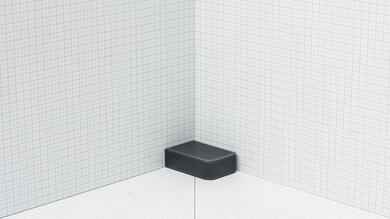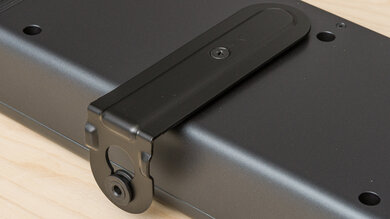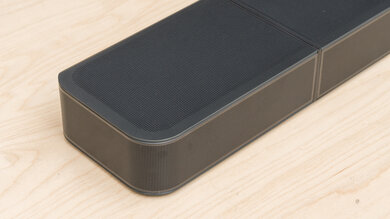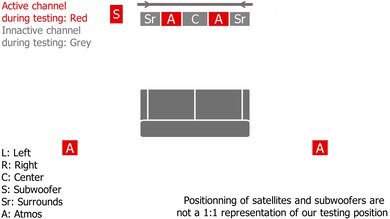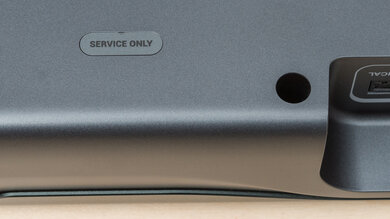The JBL Bar 1300X is a premium 11.1.4 Dolby Atmos soundbar. Similar to the JBL Bar 9.1 and the JBL Bar 1000, it has detachable truly wireless satellites that you can place anywhere in your living room to create the most immersive sound possible. These satellites are advertised to last up to 10 hours off a single charge, though they lasted even longer in our tests, and you can recharge them by connecting them back to the bar. The satellites also act as wireless Bluetooth speakers, and you can pair them to one device for audio playback or connect them to make a stereo pair.
Our Verdict
The JBL Bar 1300X is good for mixed usage. This 11.1.4 soundbar is suitable for lots of different audio content, from music to movies to TV shows. With its discrete center channel, dialogue is clear and present in the mix, and its large subwoofer is great for feeling the rumble in bass-heavy music. There's lots of support for immersive audio formats often found on streaming platforms like Dolby Atmos. Up-firing channels built into the bar and the satellites bring an immersive all-around feel; you can even move the satellites around to get the sound you want.
-
Room correction tool.
-
Extended low-bass.
-
Dolby Atmos support.
-
Truly wireless satellites.
-
No HDMI 2.1 support.
The JBL Bar 1300X is excellent for dialogue-centric TV shows and podcasts. This soundbar has a discrete center channel designed to improve the quality of vocal reproduction. Its ClearVoice dialogue enhancement tool is also available to make dialogue clearer and more crisp in the mix. With relatively low latency, you don't notice any lip-synching issues with videos or movies, either. If you prefer dialogue-only content like podcasts, lots of wireless playback options are available to stream from your mobile devices.
-
Room correction tool.
-
Graphic EQ.
-
No traditional bass and treble adjustments.
The JBL Bar 1300X is decent for music. Like most premium bars, this setup has a room correction feature designed to calibrate the bar's sound based on your room's acoustics. A 3-band graphic EQ is available in the JBL ONE companion app if you want to adjust its sound manually. You may not want to, though—out-of-the-box, the bar has a great stereo frequency response, with clear and detailed reproduction of instruments in the mix. The big sub has no trouble reproducing a deep, extended low bass. However, there's some considerable compression as you crank the volume that can affect audio quality.
-
Room correction tool.
-
Graphic EQ.
-
Extended low-bass.
-
No traditional bass and treble adjustments.
The JBL Bar 1300X is decent for movies. This premium 11.1.4 soundbar supports many of the audio formats commonly found on both streaming platforms and Blu-rays, such as Dolby Digital and Dolby Atmos. Its two satellites are detachable from the bar, and you can place them anywhere in your room to get a more immersive feel. Dialogue is clearly reproduced, too, and the sub brings out all the thump and rumble in action-heavy scenes. However, with Dolby Digital and Dolby Digital Plus, incorrect implementation means that effects meant for the left and right surround channels don't play as intended, which takes away from the clear and real feel of the audio content.
-
Extended low-bass.
-
Dolby Atmos support.
-
Truly wireless satellites.
-
No traditional bass and treble adjustments.
- 7.6 Mixed Usage
- 8.2 Dialogue/TV Shows
- 7.3 Music
- 7.4 Movies
- Updated Sep 23, 2024: Updated Stereo Dynamics results with new methodology from TBU 1.3. Added text to Audio Latency: ARC, Audio Latency: HDMI In, and Audio Latency: Optical boxes. We've also retested this bar's Dolby Digital and Dolby Digital Plus implementation using firmware OneOS2.3 (24.33.31.80.00) and found that these formats are still incorrectly implemented.
- Updated Sep 19, 2024: We've converted this review to Test Bench Update 1.3. If applicable, we've retested stereo sound based on the manufacturer's recommendations. Additionally, we've expanded our audio latency tests to the following boxes: Audio Latency: ARC, Audio Latency: HDMI In, and Audio Latency: Optical. You can see the full changelog here.
- Updated Aug 24, 2023: Following user feedback, added more information about the bar's up-firing channels to the Height (Atmos) box.
- Updated Jul 10, 2023: Added market comparison with the JBL Bar 500 to the Dimensions - Satellites box.
- Updated Jun 09, 2023: Updated the 4k Max Refresh Rate result to 60Hz.
- Updated May 16, 2023: Tested the satellite speaker's battery life and added the results to the Style - Satellites box.
- Updated May 11, 2023: Review published.
- Updated May 08, 2023: Early access published.
- Updated May 04, 2023: Our testers have started testing this product.
- Updated Apr 17, 2023: The product has arrived in our lab, and our testers will start evaluating it soon.
- Updated Apr 05, 2023: We've purchased the product and are waiting for it to arrive in our lab.
Differences Between Sizes And Variants
The JBL Bar 1300X is available in Black and the label for our model is available here.
If you come across another version of the bar, let us know in the forums so we can update our review.
Compared To Other Soundbars
The JBL Bar 1300X is a premium soundbar setup with more channels than similar models like the JBL Bar 1000 or the JBL Bar 9.1. Still, it retains JBL's signature design, with truly wireless satellites that make its soundbars stand out from the competition. It provides an immersive sound overall, with lots of sound enhancement features to make the most of your listening experience. Plus, the large subwoofer brings a lot of bass, great for fans of genres like EDM and hip-hop.
You can also take a look at our recommendations for the best soundbars, the best Dolby Atmos soundbars, and the best soundbars for movies.
The Samsung HW-Q990C is a better 11.1.4 setup than the JBL Bar 1300X. The Samsung has a better sound quality overall, with a more balanced sound right out of the box. It can get louder, too, with less compression at max volume. It offers built-in voice assistant support, whereas you have to buy a third-party device to control the JBL with your voice. Some users may prefer the JBL's truly wireless satellites, which can be used as Bluetooth speakers and don't need to be plugged into an outlet to work.
The JBL Bar 1300X is better than the JBL Bar 9.1. The 1300X is an 11.1.4 setup with a larger sub, and it's able to reproduce a touch more bass. Plus, it has more channels than the 5.1.4 Bar 9.1, and its height performance is better overall. You can even use its satellites as Bluetooth speakers, which is cool. That said, it can't get as loud and there's significantly more compression at max volume.
The JBL Bar 1300X is better than the JBL Bar 1000. The 1300X is an 11.1.4 setup, meaning that it comes with more channels than the 7.1.4 1000. Both bars boast similar designs, but the 1300X offers better sound quality, especially with Dolby Atmos content. It's able to reproduce more height, so you get the feeling of effects coming from above and behind you. Plus, the 1300X's satellites can be used as Bluetooth speakers, which is a cool touch.
The Bose Smart Soundbar 900 with Speakers + Bass Module is better than the JBL Bar 1300X. The Bose is a premium 5.1.4 setup with a better stereo soundstage, resulting in a more immersive sound overall. It really shines in terms of sound quality, though it doesn't offer quite as many features as the JBL. For example, the JBL has HDMI In ports for video passthrough, unlike the Bose, and it supports more audio formats. Your listening habits may dictate which bar is best for you overall.
The JBL Bar 1300X is a more premium setup than the JBL Bar 500. The 1300X comes with discrete satellite speakers that offer better surround sound. Since it comes with up-firing drivers, too, it offers true Dolby Atmos support, unlike the 500. That said, it does have some implementation issues with Dolby Digital and Dolby Digital Plus content. Sound effects meant for the surround channels play from the bar simultaneously, reducing the overall life-like feel of this content.
Test Results
The JBL Bar 1300X is a premium soundbar with a similar design to the JBL Bar 1000 and the JBL Bar 9.1. The bar comes with two detachable satellite speakers, and since they're truly wireless, you can place them anywhere in your setup without having to plug them into an outlet. Plus, when you detach the speakers, you can use the included caps to cover the sides of the bar. The caps are made of a metal grille, which lets sound pass through the bar's side drivers. You can see what the bar looks like without the attached satellites here.
The sub looks very similar to the model that comes with the JBL Bar 1000. It's quite large, and it sits on four raised plastic legs. The port is in the rear.
The satellites, like the bar, are made of hard plastic, with a metal grille on top. You can keep them attached to the bar or detach them as satellite speakers. There aren't end caps for the speakers themselves, but you can cover the sides of the bar with the included caps. The manufacturer says that they support up to ten hours of playtime, and they take about four hours to charge from an empty battery. We tested this for ourselves, though, and the speakers lasted a whopping 31 hours. Plus, you can pair one satellite to a Bluetooth device to use it as a standalone speaker or pair both together for stereo sound, which is a cool touch.
The bar is quite wide, so it doesn't fit easily between the legs of a 55-inch TV stand. Our measurements represent the bar with the satellites detached since that's how you're likely to use it, but with the satellites on the bar, the overall width is 54.2 inches (137.7 cm) which is also likely too wide to fit between a 55-inch TV stand.
The satellites are a bit larger than those that come with the JBL Bar 1000. They're wide, but also not very tall, so they don't take up too much space in your setup. If you don't have room for satellites, you can always check out a bar like the JBL Bar 500 instead.
The JBL Bar 1300X has a great build quality. The bar and the satellites are both made of plastic, which feels very solid and durable. The metal grilles help to protect the drivers inside, which is a nice touch, and the included caps protect the pins when you detach the satellites. The subwoofer also seems very sturdy. There's no fabric in its build, so you don't have to worry about ripping or collecting dust over time. One note is that the center of our bar has some slight rippling, which you can see here. It's possible that this is unique to our unit, though.
The JBL Bar 1300X has a great stereo frequency response without the satellites on. As with most premium bars, it has a room correction tool to calibrate its sound based on your room's acoustics, which is nice. With it on, the bar has a good overall sound, with a clear reproduction of voices and instruments in the mix. The big sub brings plenty of rumble in the bass, too, which is great for genres like EDM and hip-hop.
The bar does exhibit some unique behavior based on whether you attach or detach the satellites, or whether it's set to the Smart Mode virtual surround feature.
- Bar with satellites docked on Smart Mode: Stereo content plays the left and right channels on the speakers, as well as all four up-firing drivers.
- Bar with satellites docked on Standard Mode: Stereo content plays on only the left and right channels from the speakers.
- Bar with satellites detached on Smart Mode: Stereo content plays from the bar's left and right channels as well as its center, side-firing, and up-firing channels.
- Bar with satellites detached on Standard Mode: Stereo content plays from the bar's left and right channels as well as the left and right sides of the bar.
It's all a bit confusing— a typical bar would play stereo content from the left and right stereo channels only. To best simulate how an average user would listen to stereo content with this bar, we kept it to those final settings— satellites detached, and Smart Mode off.
If you prefer a more balanced sound with stereo content, we recommend setting the subwoofer level to 2. The resulting frequency response is a bit more even and balanced, especially in the bass range. As a result, you notice less boom in the mix.
The JBL Bar 1300X's stereo soundstage is good. The soundstage is perceived to be about as wide as the bar itself, though it doesn't have any tricks to make it seem wider than that. The focus is very good, though, which is a plus, especially if you want to hear the separation of instruments between the left and right channels of your bar.
This bar gets loud enough to fill the average living room with sound. That said, there's some significant compression at max volume that can impact the clarity of audio reproduction as you crank up the volume.
The JBL Bar 1300X is an 11.1.4 setup that comes with a discrete center channel designed to improve the quality of vocal reproduction in the mix. The frequency response on this channel is very even and balanced, especially in the mids, meaning that dialogue is clear and accurate in its reproduction.
The JBL Bar 1300X has two discrete satellites designed to bring a more clear and real feel to 5.1 surround content such as Dolby Digital. Effects stretch into the space around your couch, so you feel more immersed in the sound. However, these channels have a bass-heavy sound, so some details are a bit muddy in the mix compared to models like the Samsung HW-Q990C.
The JBL Bar 1300X is a Dolby Atmos soundbar with up-firing channels designed to ricochet sound effects off the ceiling to create the illusion of height with height content. There are six drivers— four on the bar and two on the satellites. JBL reports only four channels, though. The pair of drivers in the bar essentially function as one channel sending the same sound.
Overall, the frequency response of these channels is quite balanced, albeit with some extra rumble in the bass, so you feel the boom of a helicopter flying overhead, for example. You can also use the ATMOS and REAR buttons on the remote to adjust the height and rear levels, respectively, for a more immersive sound.
Additionally, we subjectively evaluated the bar's Atmos performance to get a better sense of the soundstage and overall immersive feel with this content. Out-of-the-box, the sound is pretty much all around you, with good definition of details and effects as reproduced by the bar. It's missing a bit of sound over your head and behind you, though you can fix this a bit with the mentioned ATMOS and REAR tools. The Smart Mode virtual surround feature does improve the soundstage, too, but it also introduces a 'fake' or 'forced' quality to the sound that isn't ideal for everyone. You can play around with these settings to get the experience that's best for you.
The JBL Bar 1300X comes with lots of sound enhancement features to make the most of your listening experience. As with most premium models on the market, there's a room correction tool available to optimize its sound based on your room's unique acoustics. If you would rather adjust its sound manually, there's also a 3-band graphic EQ in the JBL ONE app, as well as a subwoofer level adjustment. PureVoice acts as a dialogue enhancement tool, and Smart Mode is a virtual surround setting designed to add richness to sound effects in the mix. Plus, you can activate the Night Mode feature by holding the Mute button on the remote for five seconds, then pressing the '-' button.
You can connect the JBL Bar 1300X to your TV over HDMI or Optical. With three HDMI In ports, you have a lot of flexibility for video passthrough between devices like a TV and a PC as well. There's even USB audio playback with US models like our unit, though other region-specific versions are limited to service updates through the USB port.
This bar supports many audio formats commonly found on streaming platforms and Blu-rays. However, when you play Dolby Digital or Dolby Digital Plus content, audio intended for the left and right surround channels also plays from the bar at the same time. This is true whether Smart Mode is on or off. As a result, you don't get the same pinpoint localization of sound effects with this content— for example, a car seems like it's coming from a general area, rather than an exact spot, as it races past.
The JBL Bar 1300X also supports common 5.1 surround sound formats like Dolby Digital as well as lossless and object-based formats like Dolby Atmos via HDMI In. However, the bar doesn't implement Dolby Digital or Dolby Digital Plus content as intended. Even after installing firmware update OneOS2.3 (24.33.31.80.00), Dolby Digital content will only play from the front channels, with no audio from the rear speakers. With Dolby Digital Plus content, surround sound audio would also incorrectly play from the front two channels.
Dolby Digital is the most common surround sound format, and unfortunately, the same incorrect implementation is found over Optical. Again, even after installing firmware update OneOS2.3 (24.33.31.80.00), you notice effects meant for the left surround channel on both the bar and the left satellite and effects meant for the right surround channel on both the bar and the right satellite with Dolby Digital Plus content. With Dolby Digital content, no audio would play from the rear speakers. Unlike other JBL bars, this is the case regardless of whether Smart Mode is on or off.
Audio latency using an HDMI eARC connection is decent, so you're unlikely to notice any lip sync issues between your audio and video using this connection type. It's worth remembering that different displays and devices compensate for latency differently. However, you can always use the Audio Sync feature on the remote to manually compensate for any latency.
Latency is okay when using the bar's HDMI In port, though depending on your display or the app you use, you may encounter lip sync issues. However, you can always use the bar's Audio Sync feature to manually compensate for any latency.
This bar's latency is passable using an optical connection. However, it's possible that you'll experience AV sync issues, as different devices and displays compensate for latency differently. You can always manually adjust for this using the Audio Sync function.
You can use the JBL Bar 1300X as a hub between devices like a TV and a PC for video passthrough. It supports most common resolutions up to 4k @ 60Hz, though it can't passthrough a smoother and more natural-looking 120Hz display at a 4k resolution. Support for various virtual refresh rate technologies is also handy if you want a tear-free gaming experience.
It's easy to wirelessly stream audio from your mobile devices to the bar over a variety of platforms.
There's a simple remote so you can control the bar from your couch. Plus, you can download the JBL ONE app to control the bar from your mobile device. There's a video of the app here.







